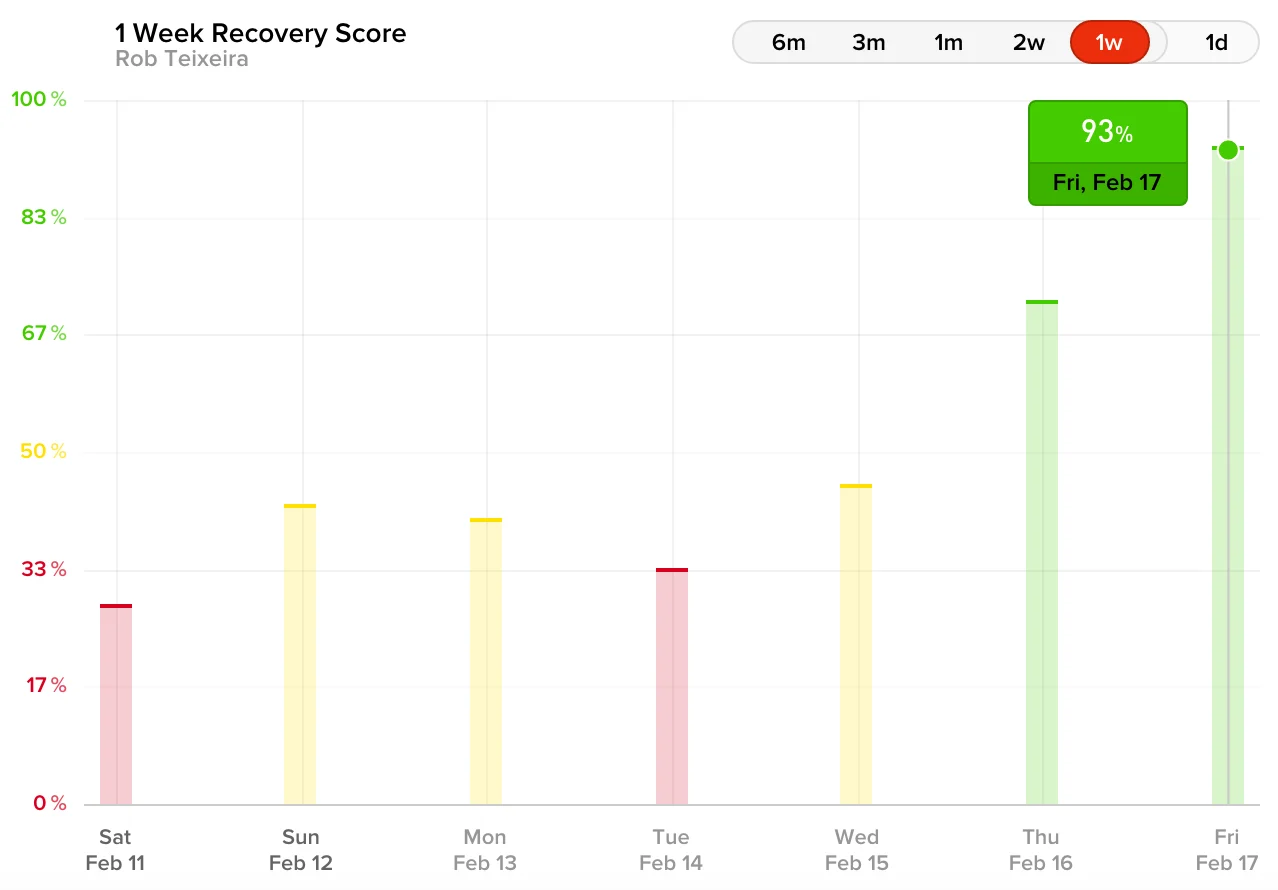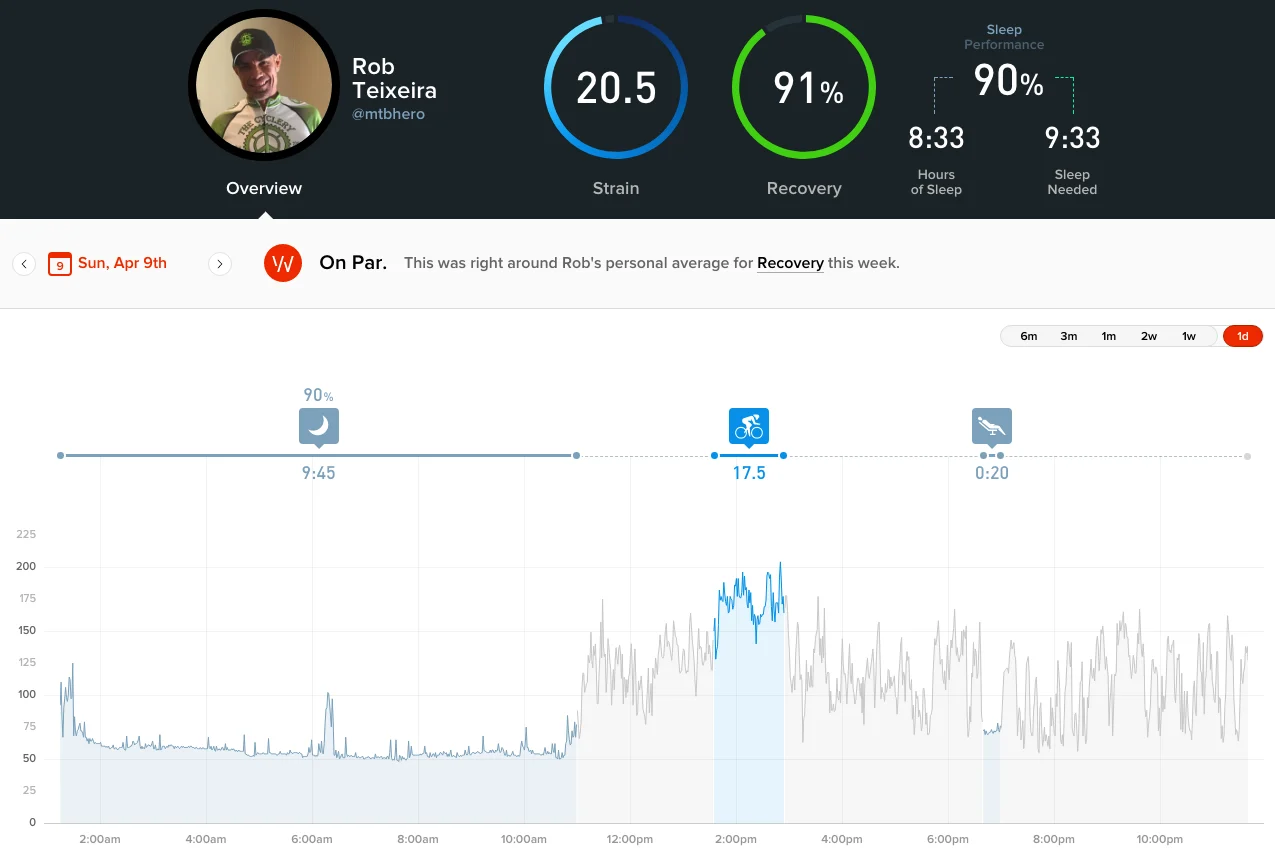Topics
- Article
A Firefighter and Mountain Biker's Strain and Recovery Journey

As a Los Angeles firefighter, Rob Teixeira’s day-to-day life puts an enormous amount of Strain on his body–even before you throw in the fact that he’s a father of three, a hardcore athlete and competitive mountain-bike racer.
The 48-year-old has been a fireman for 18 years, but athletics is his true calling. “Back in the day I was a bodybuilder,” Rob told WHOOP. “When I was 24, I underwent a congenital heart surgery. I had an ablation, a procedure where they go in through your femoral artery with these very thin catheters and map out your heart. I had two AV (atrioventricular) nodes removed that were disrupting my heart rate.”
“After the surgery, my thinking was that I should be doing more cardio workouts to strengthen my heart, so I got into road cycling,” Rob said. “That started my whole cardio journey. I went from 205 pounds to 160 pounds in just a few months.” Rob has been a dedicated cyclist ever since.
“A few years ago, I converted from a road dude to mountain biking when I saw an elite race for the first time,” he said. “It had such a cool vibe, I loved the camaraderie and I dug the grittiness of it. I sold my road bike and went all in.”
In what little spare time he has left over, Rob is also a coach and trainer: “I always loved training. Twenty years ago, I started out as a strength trainer, then I became a certified cycling coach. When I joined the fire department, helping fellow firefighters was a natural fit. Eventually I became the fitness coordinator for the entire Los Angeles County fire department, one of the largest in the country.”
When speaking to Rob, he sounds like a laid-back guy from southern California. However, he clearly brings great levels of passion and intensity to everything he does: “I show people my WHOOP activity log and they ask why I’m exercising at 3 am, ‘No man, that’s just my work,’ I say. We work 24-hour shifts. Reviewing my data the morning after each shift is a huge eye opener. I’ve learned how much the Strain from waking up and running 911 calls in the middle of the night is costing my next day Recovery.”
Here’s a look at Rob’s heart rate and Sleep during a typical night at the firehouse. On this occasion, he woke up five different times for a total of 2:04 of the 9:06 he attempted to Sleep:

Last winter, Rob suffered a left-sided inguinal hernia while “lifting a 600-pound patient into an ambulance.” A short time later, he bought his WHOOP Strap. He had surgery to repair the hernia on January 31st and was determined to get back to racing as soon possible. “I wanted WHOOP to guide my rehab,” Rob said. “My plan was to train as hard as I could when I was recovered, and take the days off when I wasn’t. Typically I’d be a hammerhead and train through it, but I decided I didn’t want to be recovering from surgery and recovering from workouts too.”
On February 9th, just over a week after his operation, Rob got back on the bike–an indoor stationary bicycle, per doctor’s orders. He rode for 10 minutes, recording a Strain of 4.2 (the Strain of his workouts appears in blue below):

It was a little more than he could handle, so when Rob tried again on Saturday February 11th, he kept his workout Strain to a 0.5. He then followed that up with a 4.1 on February 14th before easing back into more strenuous workouts on February 17, when he awoke that morning with a 93% Recovery:

“In using WHOOP to come back I was getting a baseline,” Rob said. “For the first time I could quantify the actual load, the Strain. It helped me to pace myself and get out of the athlete mentality of ‘don’t complain, get up and do your training, do what you’ve got to do on the calendar.’ I rested more and decided to start just taking what my body gave me, which allowed me to progress much quicker than I had expected. Within 8-9 weeks, I was back to racing.”
On April 9th, Rob competed in his first race since the injury, finishing 14th overall in the Bonelli Park U.S. Kenda Cup #3 Race Series in San Dimas, California.
“WHOOP lets you see if you’re jumping back in too soon and tells you your current readiness,” Rob noted. “It helped me pace myself to maximize Recovery. Otherwise, I totally would’ve overtrained and I wouldn’t have been able to make my race.”
On race day, during which he registered a 17.5 Strain while competing and a 20.5 overall Day Strain, Rob was 91% Recovered:

Being the driven competitor that he is, Rob casually mentioned that he still didn’t quite feel back to normal at that time. However, less than a month later, he finished 2nd in his age group and placed 3rd overall at an Xterra Renegade Off-Road Duathlon, a race consisting of two 3-mile trail runs and a 15-mile mountain bike ride.

“As a 48-year-old athlete, I’m seeing the best results from my training that I’ve seen in a long time,” Rob added. “And as a 20-year endurance coach, I now have a much better understanding of the relationship between Strain and Recovery, which I’m using to help fellow firefighters and mountain bikers improve their performance on the job and on the trails.”
Rob’s next big race will be in August at the World Police and Fire Games, held this year in Los Angeles. He says he’s hoping to win against international competition.
Takeaways for WHOOP Users
- Rob pointed out that he didn’t want to be recovering from surgery and workouts at the same time. Dialing back your training routine when you’re sick or injured, even if you’re physically capable of exercising, will better allow your body to heal.
- Even if you regularly take on very high levels of Day Strain, lowering it by small amounts when you’re looking to peak can improve next-day Recovery.
RELATED: Using Day Strain to Adjust Workouts: A Mail Carrier’s Story
Have a WHOOP story you’d like to share? Email TheLocker@whoop.com. And make sure to check out @whoop on Instagram, Twitter and Facebook.